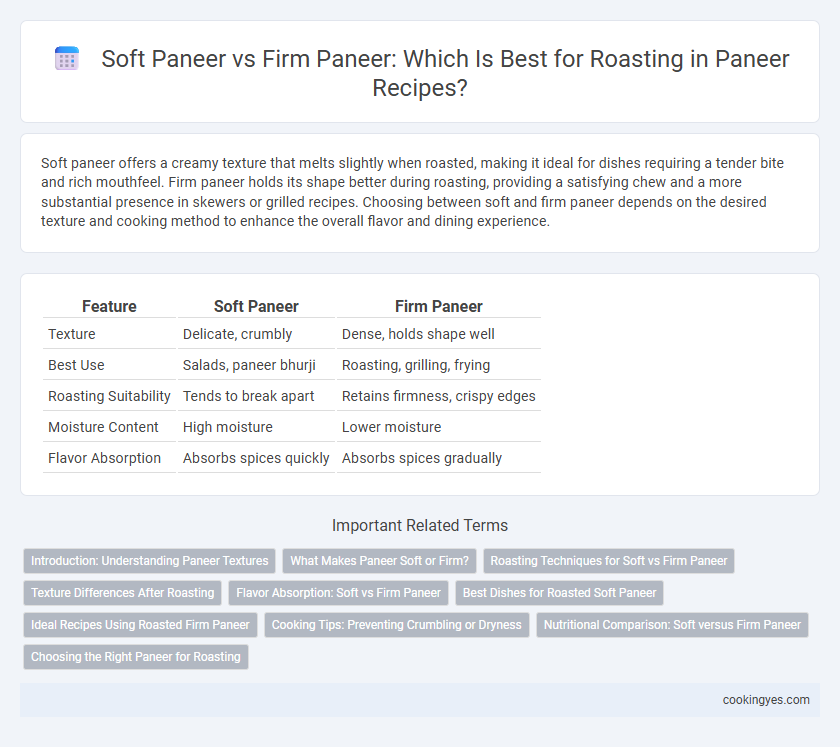Soft paneer offers a creamy texture that melts slightly when roasted, making it ideal for dishes requiring a tender bite and rich mouthfeel. Firm paneer holds its shape better during roasting, providing a satisfying chew and a more substantial presence in skewers or grilled recipes. Choosing between soft and firm paneer depends on the desired texture and cooking method to enhance the overall flavor and dining experience.
Table of Comparison
| Feature | Soft Paneer | Firm Paneer |
|---|---|---|
| Texture | Delicate, crumbly | Dense, holds shape well |
| Best Use | Salads, paneer bhurji | Roasting, grilling, frying |
| Roasting Suitability | Tends to break apart | Retains firmness, crispy edges |
| Moisture Content | High moisture | Lower moisture |
| Flavor Absorption | Absorbs spices quickly | Absorbs spices gradually |
Introduction: Understanding Paneer Textures
Soft paneer has a higher moisture content, making it tender and ideal for recipes requiring gentle roasting or minimal browning to preserve its creamy texture. Firm paneer, with lower moisture, holds its shape better under high-heat roasting, developing a crispy exterior while maintaining a chewy interior. Understanding these textural differences ensures optimal culinary results and enhances the dish's flavor and mouthfeel.
What Makes Paneer Soft or Firm?
Paneer texture depends on the milk's fat content, acidity level, and pressing duration; higher fat and shorter pressing time yield soft paneer, while lower fat and longer pressing create firm paneer. Soft paneer retains moisture and crumbles easily, making it ideal for dishes requiring creaminess, whereas firm paneer holds shape well, perfect for roasting and grilling. The coagulation process's temperature and the amount of coagulant like lemon juice or vinegar also significantly influence paneer's softness or firmness.
Roasting Techniques for Soft vs Firm Paneer
Soft paneer requires gentle roasting techniques such as marinating with moisture-rich spices and cooking on low heat to prevent crumbling, maintaining its creamy texture. Firm paneer withstands higher heat and longer roasting times, developing a crisp, golden exterior ideal for grilling or pan-roasting. Optimal roasting enhances flavor development by caramelizing edges on firm paneer while preserving moisture in soft paneer.
Texture Differences After Roasting
Soft paneer retains a tender, creamy texture after roasting, often developing slight browning while remaining moist and delicate. Firm paneer maintains a denser, more cohesive structure, resulting in a chewier bite and well-defined grill marks post-roasting. The texture difference influences cooking methods and dish applications, with soft paneer best suited for gentle roasting and firm paneer ideal for high-heat grilling.
Flavor Absorption: Soft vs Firm Paneer
Soft paneer absorbs marinades and spices more effectively due to its porous texture, resulting in a richer and more intense flavor when roasted. Firm paneer retains its shape better during cooking but has a denser structure that limits deep flavor penetration. Choosing between soft and firm paneer depends on whether a stronger infusion of spices or a more defined, chewy texture is desired in roasted dishes.
Best Dishes for Roasted Soft Paneer
Soft paneer, with its delicate texture, is ideal for roasting dishes like Paneer Tikka and Malai Paneer Tikka that benefit from creamy, melt-in-the-mouth bites. Its ability to absorb marinades deeply enhances flavors, making it perfect for smoky, spiced recipes. Firm paneer, while better suited for grilling or frying, tends to be less absorbent and offers a more chewy texture in roasted preparations.
Ideal Recipes Using Roasted Firm Paneer
Roasted firm paneer retains its shape and texture, making it ideal for kebabs, tikka, and grilled skewers where a sturdy consistency is crucial. Unlike soft paneer, which crumbles easily, firm paneer absorbs marinades well and develops a caramelized, crispy exterior without becoming mushy. Popular recipes featuring roasted firm paneer include Paneer Tikka, Malai Paneer Tikka, and spicy grilled paneer sandwiches that benefit from its robust texture and flavor retention.
Cooking Tips: Preventing Crumbling or Dryness
Soft paneer, with its higher moisture content, is ideal for gentle roasting methods to prevent crumbling, requiring minimal handling and lower heat settings to maintain its creamy texture. Firm paneer withstands higher temperatures and longer roasting times, ensuring a crisp exterior while retaining moisture, achieved by marinating and oiling the cubes before cooking. To avoid dryness, always preheat the cooking surface and cook paneer on medium heat, turning occasionally to achieve even browning without overcooking.
Nutritional Comparison: Soft versus Firm Paneer
Soft paneer contains higher moisture content, making it lower in calories and fat compared to firm paneer, which is denser and richer in protein. Firm paneer offers more concentrated amounts of calcium and phosphorus, essential for bone health, while soft paneer retains slightly higher levels of vitamins due to less processing. Both types provide substantial amounts of casein protein, but firm paneer's texture holds up better during roasting, preserving nutritional integrity without significant nutrient loss.
Choosing the Right Paneer for Roasting
Soft paneer, with its delicate texture and higher moisture content, tends to break apart quickly when roasted, making it less suitable for high-heat cooking methods. Firm paneer, characterized by its dense structure and low moisture, holds its shape well during roasting, resulting in crispy edges and a satisfying bite. Selecting firm paneer ensures optimal texture retention and enhanced flavor absorption when roasting dishes like tikka or skewers.
Soft paneer vs Firm paneer for roasting Infographic

 cookingyes.com
cookingyes.com